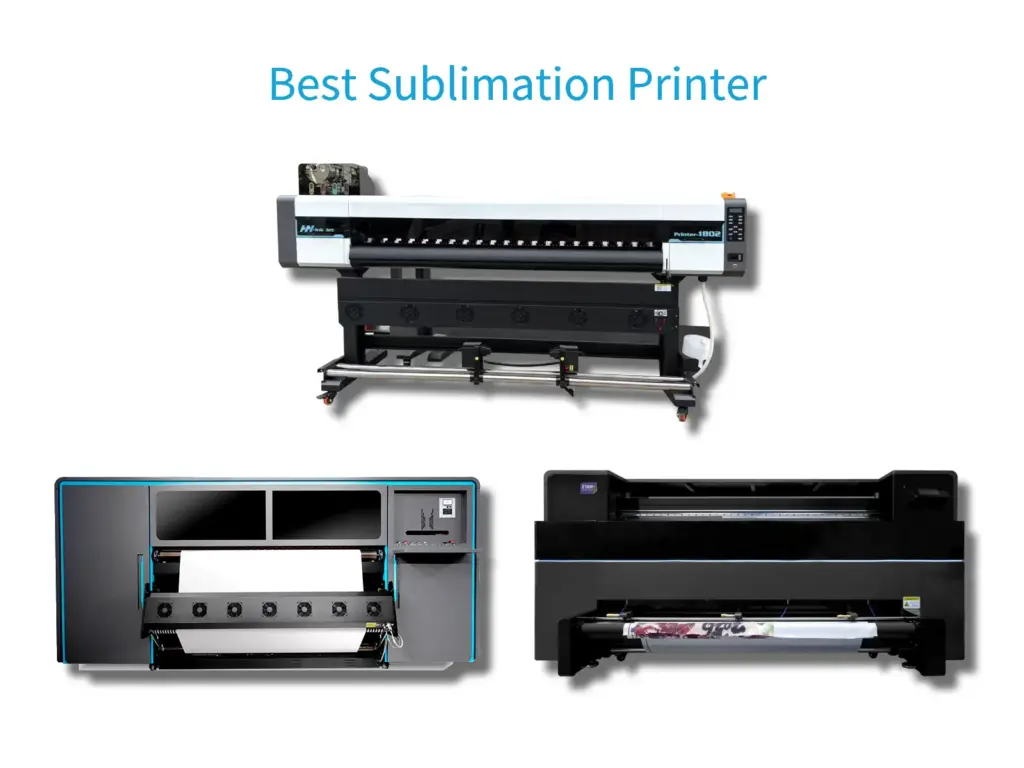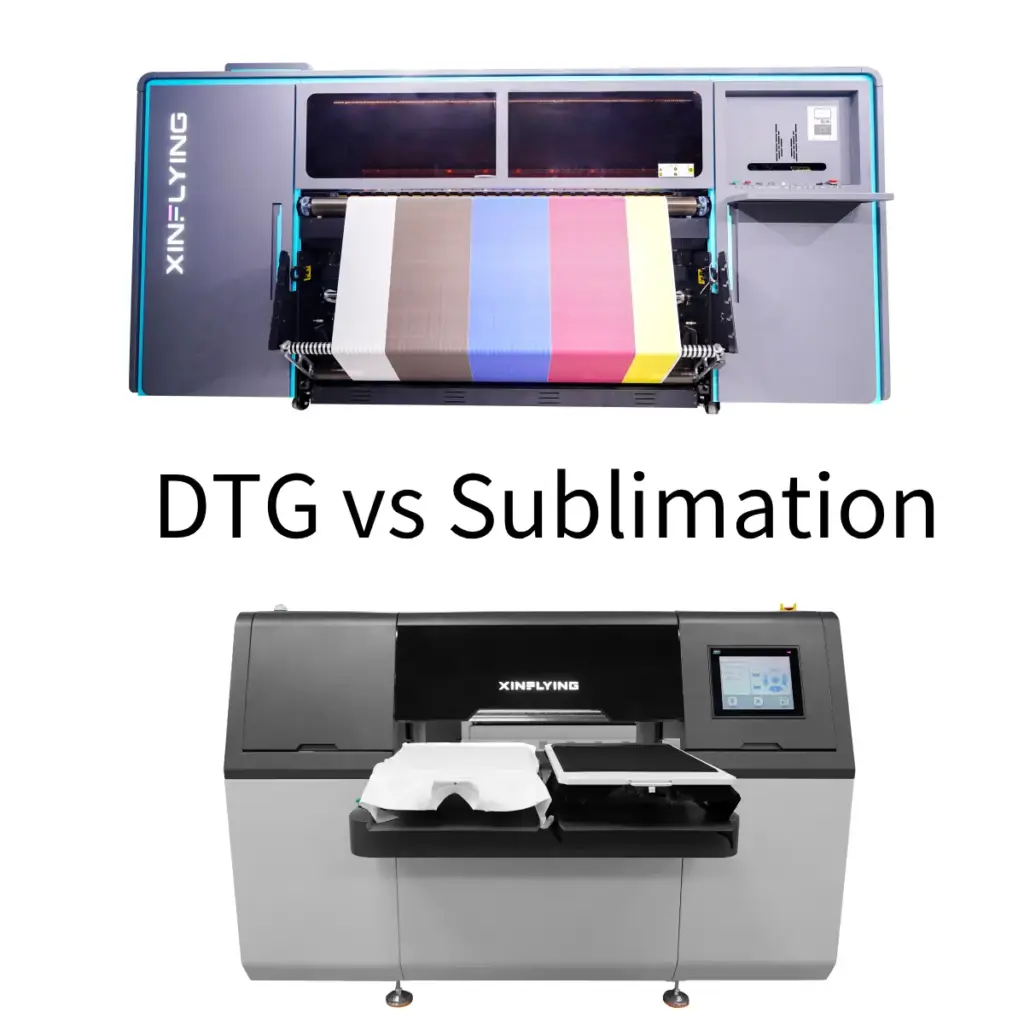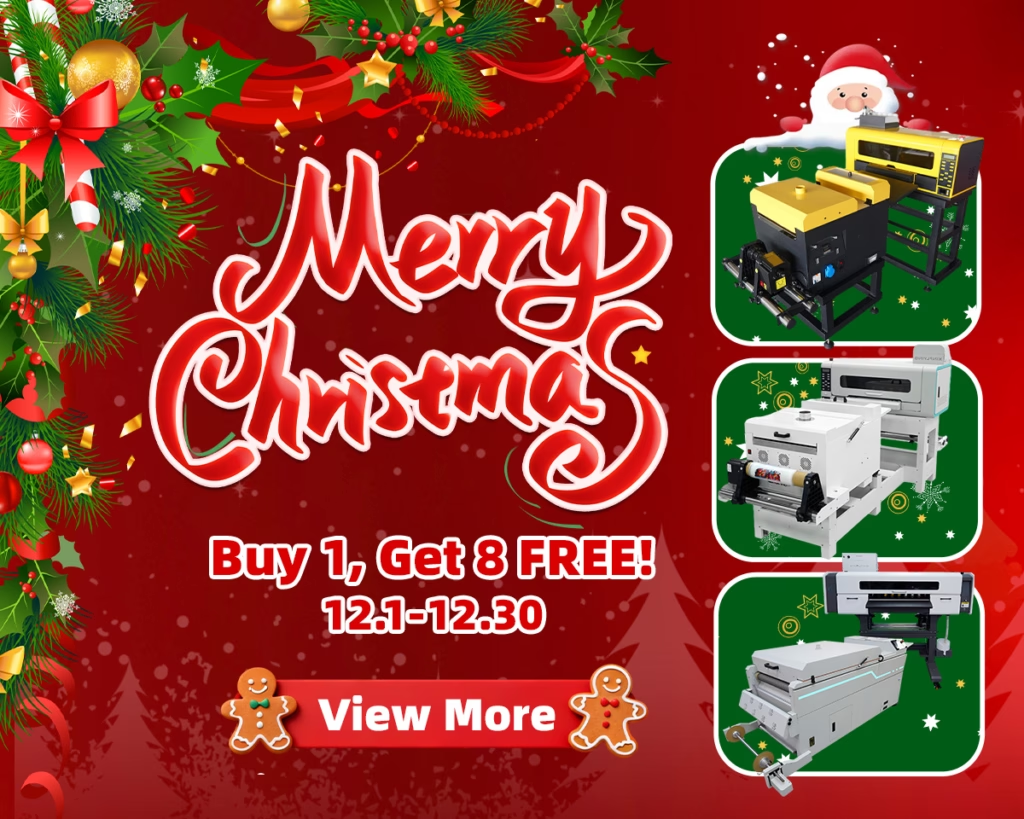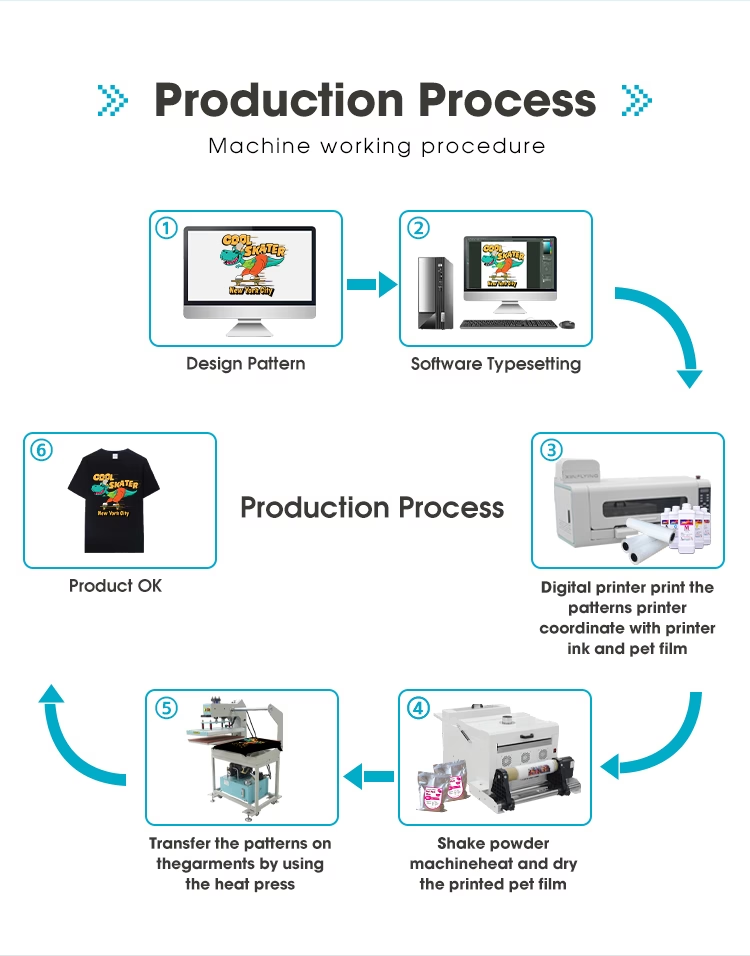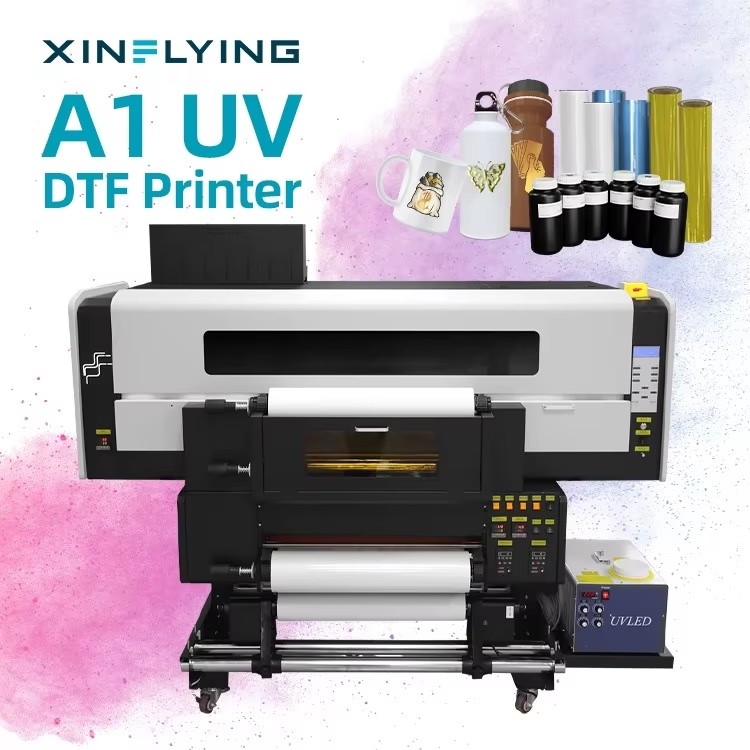인쇄 기술은 먼 길을 왔습니다, 다른 표면에 이미지를 생생하게하는 다양한 방법을 제공. 오늘날 업계에서 인기있는 두 가지 인쇄 기술은 UV DTF 인쇄 및 DTF 인쇄입니다.. 두 방법 모두 인상적인 결과를 제공합니다, 그들은 그것들을 구별하는 독특한 기능을 가지고 있습니다. 이 기사에서는, 각 인쇄 방법의 세부 사항을 조사 할 것입니다., 그들의 강점과 한계를 비교하십시오, 필요에 맞는 올바른 인쇄 방법 선택에 대한 지침을 제공하십시오..
UV DTF 인쇄란 무엇입니까??
UV DTF 인쇄, 필름 인쇄에 직접 자외선이 부족합니다, 고품질 이미지가 다양한 기판으로 전송할 수있는 최첨단 기술입니다.. 기존의 인쇄방식과는 다르게, UV DTF 인쇄 자외선을 사용합니다 (UV) 탁월한 내구성과 생생한 색상을 위해 자외선으로 치료되는 잉크.
UV DTF 프린터 사용 방법?
단계 1: RIP 소프트웨어에 디자인
첫째로, 컴퓨터의 RIP 소프트웨어로 아트 워크를 준비하십시오. 그런 다음 UV DTF 프린터 플랫폼에 UV DTF를 배치하십시오..
단계 2: 필름에 인쇄하기
CMYK 잉크로 카트리지를 미리 채우세요., 흰색 잉크, UV DTF A 필름에 디자인을 인쇄하기 위한 바니시.
단계 3: 라미네이트 B 필름
인쇄 된 필름을 라미네이팅 머신에 넣어 B 필름과 함께 붙여 넣으십시오..
단계 4: 제품에 필름을 붙이세요
패턴의 A필름을 떼어내고 인쇄하고 싶은 아이템에 붙여주세요.. 그런 다음 B 필름을 천천히 떼어내세요., 그리고 당신의 제품은 완성되었습니다.
UV DTF 인쇄의 장점과 단점

UV DTF 인쇄의 장점
- 높은 이미지 품질과 선명도
UV DTF 인쇄는 날카로운 세부 사항과 생생한 색상으로 뛰어난 이미지 품질을 제공합니다.. UV 잉크에는 넓은 색 영역이 있습니다, 정확한 색상 재현이 가능합니다..
- 넓은 색 영역
UV DTF 인쇄는 다양한 기판에 다양한 색상을 인쇄 할 수 있습니다., 풍부하고 생생한 디자인을 초래합니다.
- 빠른 생산 시간
전통적인 인쇄 방법과 비교합니다, UV DTF 인쇄는 더 빠른 생산 시간을 제공합니다. UV 잉크는 거의 즉시 건조합니다, 연장 된 건조 기간의 필요성을 제거합니다.
- 다양한 기판에 인쇄하는 능력
UV DTF 인쇄는 광범위한 재료에 인쇄 할 수있는 유연성을 제공합니다., 직물을 포함하여, 플라스틱, 유리, 그리고 더. 이 다목적 성은 제품 제품을 다양 화하려는 비즈니스에 이상적인 선택입니다..
UV DTF 인쇄 제한
- UV 잉크 및 장비 비용
UV DTF 인쇄에는 특수 UV 잉크 및 장비가 필요합니다, 전통적인 인쇄 재료에 비해 더 비쌀 수 있습니다.. 추가적으로, UV 잉크는 유적 수명이 짧을 수 있습니다, 빈번한 교체가 필요합니다.
- 특정 재료의 유연성이 제한적입니다
UV DTF 인쇄는 다양한 기판에 적용될 수 있습니다., 질감이나 표면 구성으로 인해 일부 재료가 적합하지 않을 수 있습니다.. 대규모 생산에 전념하기 전에 다른 재료에 대한 인쇄를 테스트하는 것이 중요합니다..
- 유지 보수 및 유지 요구 사항
UV DTF 인쇄 장비는 일관된 성능을 보장하기 위해 정기적 인 유지 보수 및 유지가 필요합니다.. 여기에는 프린터 헤드 청소 및 UV 경화를위한 최적의 조건 보장이 포함됩니다..
DTF 인쇄란??
DTF 인쇄, 또는 필름 인쇄에 직접, 특수 잉크를 사용하여 필름에 디자인을 인쇄하는 기술입니다., 이는 나중에 원하는 기판으로 전달된다.
DTF 프린터 사용 방법?
단계 1: RIP 소프트웨어에 디자인
UV DTF 인쇄와 유사합니다, 그래픽 디자인 소프트웨어를 사용하여 아트 워크를 설계하십시오, 원하는 디자인 및 이미지 품질이 달성되도록합니다.
단계 2: 애완 동물 영화에 인쇄하십시오
애완 동물 필름을 DTF 프린터 트레이와 인쇄를 시작합니다. 그런 다음 디자인 패턴이 전송됩니다..
단계 3: 파우더가있는 본드 잉크
분말 진탕기로, 그만큼 DTF 접착제 분말 애완 동물 필름에 골고루 퍼져 그래픽을 건조시킬 수 있습니다..
단계 4: 섬유에 전사 패턴
DTF PET 필름을 기판 상단에 놓고 Heat Press Machine을 사용하여 설계를 전송하십시오..
DTF 인쇄의 장단점
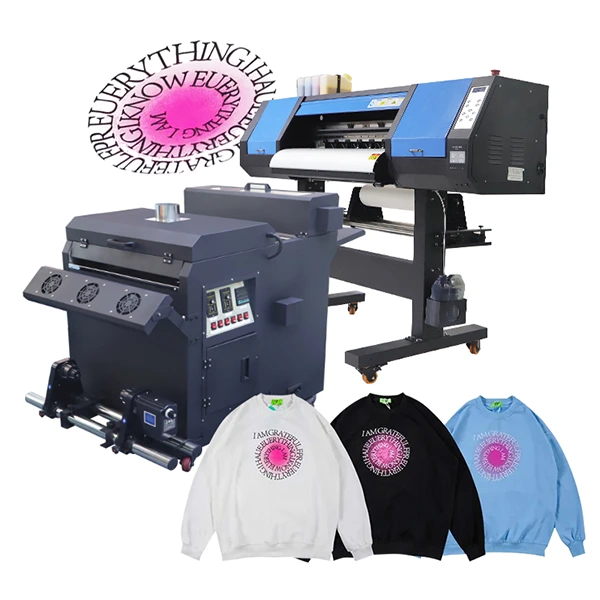
DTF 인쇄의 장점
- 비용 효율적인 인쇄 방법
DTF 인쇄는 비용 효율적인 것으로 간주됩니다, 주로 UV DTF 인쇄에 비해 장비 및 잉크 비용이 낮기 때문입니다.. 이로 인해 소기업과 인쇄 산업에 모험을 원하는 개인이 이용할 수 있습니다..
- 호환 가능한 기판 측면에서 다양성
UV DTF 인쇄처럼, DTF 인쇄는 다양한 기판에서 인쇄 할 수 있습니다, 직물을 포함하여, 세라믹, 플라스틱, 그리고 더. 이 다목적 성은 DTF 인쇄를 사용하여 생산할 수있는 제품의 범위를 확장합니다..
- 생생한 색상과 세부 사항을 달성하는 능력
DTF 인쇄는 생생하고 생생한 색상을 달성 할 수 있습니다, 좋은 세부 사항뿐만 아니라, 복잡한 디자인과 복잡한 아트 워크에 적합합니다.
- 사용하기 쉽고 깨끗합니다
DTF 프린터는 사용자 친화적입니다., 최소 설정 및 유지 보수가 필요합니다. 추가적으로, 청소 과정은 비교적 간단합니다, 더 부드러운 작동 및 가동 중지 시간이 줄어 듭니다.
DTF 인쇄 제한
- UV DTF에 비해 제한된 색 영역
DTF 인쇄는 생생한 색상을 달성 할 수 있습니다, UV DTF에 비해 색 영역이 더 좁을 수 있습니다., 재현 할 수있는 그늘과 톤의 범위 제한.
- 더 긴 생산 시간
DTF 인쇄는 설계를 기판으로 전송하기위한 추가 단계가 필요할 수 있습니다., UV DTF 인쇄에 비해 생산 시간이 더 길어질 수 있습니다..
- 특정 직물에 대한 추가 단계가 필요할 수 있습니다
특정 직물은 인쇄하기 전에 전처리 공정이 필요할 수 있습니다 DTF 잉크. 이것은 전체 인쇄 과정에 복잡성과 시간을 더할 수 있습니다..
UV DTF 대 DTF: 비교
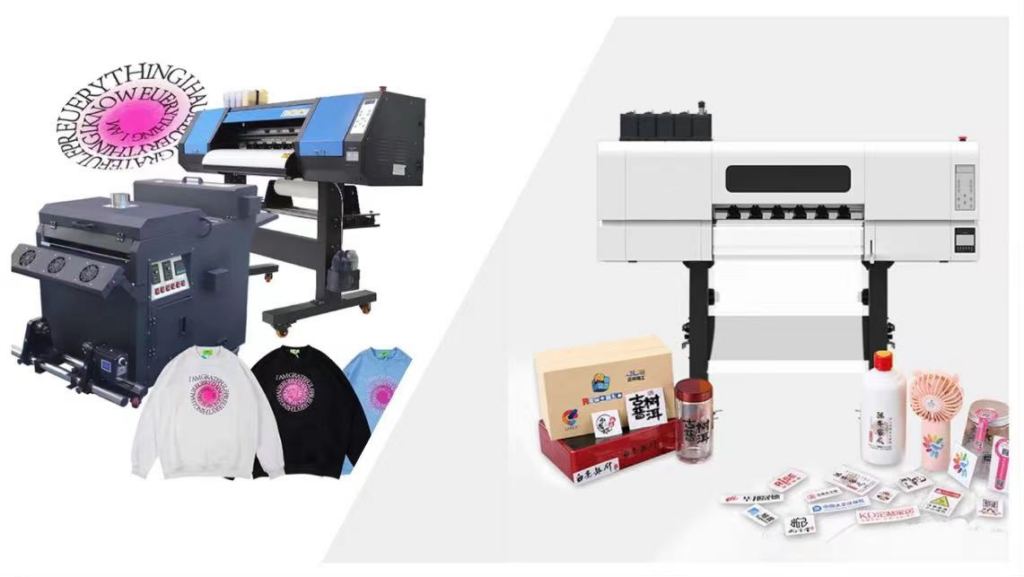
에이. 인쇄 품질 비교
해상도와 선명도
UV DTF 및 DTF 인쇄는 모두 날카로운 세부 사항으로 고해상도 인쇄를 달성 할 수 있습니다.. 하지만, UV DTF 인쇄는 UV 경화 과정으로 인해 약간 더 선명한 결과를 제공 할 수 있습니다., 잉크 영구성을 향상시킵니다.
색상 정확도 및 생동감
UV DTF 인쇄는 일반적으로 더 넓은 색 영역을 제공합니다, 보다 정확한 색상 재생 및 생생한 디자인을 허용합니다. DTF 인쇄, 생생한 색상이 가능합니다, 특정 음영과 색조를 달성하는 데 제한이있을 수 있습니다.
비. 기질의 유형
직물 옵션
UV DTF 및 DTF 인쇄는 다양한 유형의 직물에 인쇄하는 데 사용될 수 있습니다., 면을 포함하여, 폴리에스테르, 그리고 블렌드. 하지만, DTF 인쇄는 최적의 잉크 접착력을 보장하기 위해 특정 직물에 대한 추가 단계 또는 전처리가 필요할 수 있습니다..
단단한 표면에 인쇄
유리와 같은 단단한 표면에서 인쇄 할 때, 플라스틱, 또는 도자기, UV DTF 인쇄가 선호되는 선택입니다. UV 경화 과정은 이러한 표면에서 우수한 잉크 부착 및 내구성을 보장합니다..
씨. 생산 속도와 효율성
UV DTF 인쇄는 DTF 인쇄에 비해 더 빠른 생산 시간을 제공합니다.. UV DTF 잉크의 즉각적인 건조는 연장 된 건조 기간의 필요성을 제거합니다., 보다 효율적인 워크 플로우를 허용합니다.
디. 비용 비교
UV DTF 인쇄는 일반적으로 전문 UV 잉크 및 장비로 인해 선불 비용이 더 높습니다.. DTF 인쇄, 반면에, 시작하는 사람들에게보다 비용 효율적인 진입 점을 제공합니다.
인쇄 벤처.
이자형. 유지 보수 및 유지 요구 사항
UV DTF 및 DTF 인쇄 장비는 정기적 인 유지 보수와 유지가 필요합니다.. 하지만, UV DTF 프린터는 UV 잉크의 특성으로 인해 더 자주 청소 및 잉크 교체가 필요할 수 있습니다..
DTF 대 UV DTF, 어느 것이 더 나은가?
| 유형 | DTF 인쇄 | UV DTF 인쇄 |
| 기술 | 영화에 인쇄 한 다음 열을 재료에 눌렀습니다.. | DTF 기술과 UV 라이트를 결합하여 잉크를 즉시 치료합니다.. |
| 잉크 | cmyk+ 흰색 잉크를 사용합니다, 명확한 애완 동물 영화에 인쇄되었습니다. | UV 잉크를 사용합니다, 명확한 애완 동물 영화에 인쇄되었습니다. |
| 애플리케이션 | 면, 폴리에스테르, 면 폴리 블렌드, 가죽, 나일론, 그리고 더. | 면, 폴리에스테르, 면 폴리 블렌드, 가죽, 나일론, 플라스틱, 목재, 금속, 그리고 심지어 유리, 그리고 더. |
| 세부 사항 | 매우 높은 이미지 품질과 디테일. | 높은 이미지 품질과 디테일, UV 프로세스는 약간 영향을 줄 수 있지만. |
| 내구성 | 내구성이 뛰어남, 그러나 UV DTF만큼 오래 지속되지 않을 수도 있습니다. | 내구성이 뛰어남, UV 프로세스는 인쇄 수명을 확장합니다. |
DTF 대 UV DTF 비교 테이블
UV DTF 인쇄를 선택할 때
UV DTF 인쇄는 생생한 색상과 날카로운 세부 사항을 가진 고품질 인쇄를 찾는 비즈니스 또는 개인에게 적합한 선택입니다.. 더 빠른 생산 시간을 우선시하는 사람들에게 이상적입니다., 단단한 표면에서 인쇄가 필요합니다, 초기 높은 비용을 수용 할 수 있습니다.
DTF 인쇄를 선택할 때
DTF 인쇄는 인쇄 업계에서 시작하는 사람들에게 비용 효율적인 옵션입니다.. 호환 기판 측면에서 다양성을 제공하며 사용 및 유지 관리가 비교적 쉽습니다.. 비용 효율성을 우선시하는 사람들에게는 DTF 인쇄가 권장됩니다., 인쇄 재료의 다양성, 그리고 단순성 작동.
올바른 인쇄 방법을 선택합니다

원하는 인쇄 품질
이미지 선명도 수준을 고려하십시오, 색상 정확도, 인쇄에 필요한 생동감. UV DTF 인쇄는이 영역에서 탁월합니다, DTF 인쇄는 인쇄 품질이 높은 인쇄 품질로보다 비용 효율적인 옵션을 제공합니다..
인쇄 할 재료의 유형
인쇄하려는 기판의 다양성을 고려하십시오.. 사전 치료가 필요할 수있는 단단한 표면이나 재료에 인쇄가 필요하다고 예상하는 경우, UV DTF 인쇄가 더 나은 선택입니다.
생산량 및 마감일
생산 마감일 또는 대량 인쇄 요구 사항이있는 경우, UV DTF 인쇄의 빠른 생산 시간이 더 적합 할 수 있습니다.. 하지만, 생산량이 주요 관심사가 아닌 경우, DTF 인쇄는 유능한 대안을 제공합니다.
사용 가능한 예산
장비에 사용 가능한 예산을 고려하십시오, 잉크, 유지 보수. UV DTF 인쇄에는 일반적으로 더 높은 선불 투자가 필요합니다, DTF 인쇄는보다 비용 효율적인 진입 점을 제시합니다. 또한, a를 선택하는 것이 중요합니다 믿을 수 있는 패브릭 프린터 제조사.
결론
결론적으로, UV DTF 인쇄 및 DTF 인쇄는 탁월한 이미지 품질과 다양성을 제공하는 두 가지 다른 방법입니다..
UV DTF 인쇄는 생생한 색상으로 탁월합니다, 날카로운 세부 사항, 그리고 다양한 기판에 인쇄하는 능력, 예산 할당이 높고 특정 인쇄 요구가 높은 비즈니스에 이상적입니다.. DTF 인쇄, 반면에, 소규모 기업 및 다양성을 추구하는 개인에게 비용 효율적인 진입 점을 제공합니다., 간단, 그리고 사용 편의성.
궁극적으로, UV DTF 인쇄와 DTF 인쇄 사이의 선택은 인쇄 요구 사항과 같은 요소에 따라 다릅니다., 기질 다양성, 생산량, 이용 가능한 예산. 이러한 요소를 고려하고 각 방법의 강점과 한계를 이해함으로써, 정보에 근거한 결정을 내리고 뛰어난 인쇄 결과를 얻을 수 있습니다..

